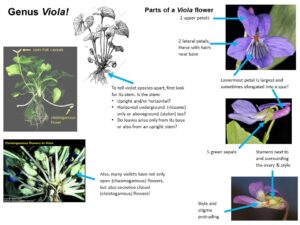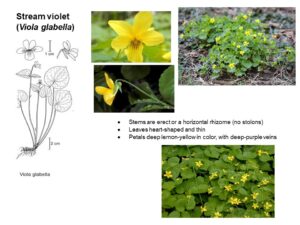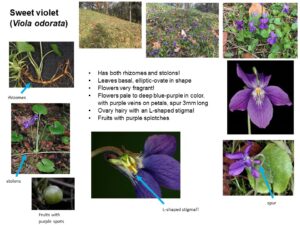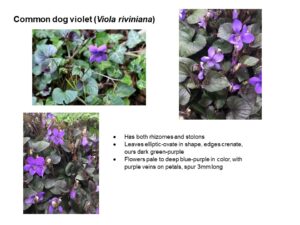Down in a green and shady bed,
A modest violet grew,
Its stalk was bent, it hung its head,
As if to hide from view…
From The Violet, by J. Taylor
Today, let’s talk about violets! Hoyt Arboretum is all about trees – different types, species, and their conservation. The Arboretum however, also has abundant natural areas with lots of different understory plants, so today we will discuss one easily-recognizable group of understory herbaceous plants called the violets, otherwise known as the genus Viola.
Genus Viola is a member of the Violaceae – the violet family- which worldwide contains about 25 genera (plural of genus) and 830 species. The Violaceae are a mostly tropical or subtropical family of plants, and can be herbs, shrubs, lianas, or small trees. Viola is the largest genus within the family (i.e., has the highest number of species) and is a mostly northern hemisphere temperate genus of annual or perennial herbaceous plants.
A few fun factoids about violets:
- Some violets are super-fragrant and sweet-smelling! Others have no noticeable odor. Those violets with no odor often have a common name of “dog” violet, as in, they are only suitable for dogs (!?).
- Many violets have nectar guides and spurs (on and formed from their petals) that attract and guide pollinators.
- Most violets have secret unopened flowers! This is a condition called cleistogamy (having cleistogamous flowers), which means that many violets develop fully-mature flowers that never open to pollinators, as those flowers are self-pollinated. They still undergo sexual reproduction and produce seeds and fruits, they just don’t exchange pollen with other plants.
- Many violet seeds have a fatty body attached to them called an elaiosome. Ants find these tiny bits of fat and nutrients attractive and will bring those seeds back into their nest and thus bury and scatter those seeds. This process of seed dispersal by ants is called myrmecochory.
- And finally…did you know? Pansies (yes, those common garden plants) and Johnny jump-ups are the genus Viola! Cultivated violets are often hybrids or special cultivars. However, African violets are not true violets! They belong to the Gesneriaceae (the Gesneriad family), a mostly tropical and subtropical group of plants.
Identifying characters of genus Viola:
- Herbaceous annuals or perennials
- Leaves simple, alternately arranged, often with stipules
- Flowers with bilateral symmetry, often with nectar guides. Sepals 5 and are persistent after flowering. Petals 5: Upper 2 petals often erect or reflexed, lateral 2 petals sometimes with beard of hairs, lowermost petal often largest and elongated into a spur.
- Flowers are bisexual (having both stamens and pistil). Stamens 5, connivant (next to and touching, but not fused) around style. Pistil with superior ovary, capsule fruit.


Violets at Hoyt Arboretum
In the Pacific Northwest, genus Viola is the only member of the Violaceae, with 26 different species. At the Arboretum, we have three naturally occurring violets (that we know about) — one native and two exotics. See how many you can find! Our native violet is yellow, very common and widespread in many areas at the Arboretum, and has flowers that last for several weeks. The two exotic violets are both blue-purple in color, are easy to spot, but are only in limited locations for a few weeks per year. See if you can find them and let us know if you find any other Viola species too!
Stream Violet (Viola glabella, native)
Viola glabella is a common understory herb in many Pacific Northwest forests. At the Arboretum, V. glabella is widespread along forested sections of the Wildwood Trail, especially just north of the Vietnam Veteran’s Memorial. It is also frequent in the forest understory in many of the coniferous sections of the Arboretum.
- Perennial herb with an erect or horizontal rhizome (no stolons)
- Leaves are thin, almost heart-shaped, edges crenate-serrate
- Leaves basal and from the stem
- Flowers with linear sepals, petals deep lemon-yellow in color, with deep-purple veins


Sweet Violet or English Violet (Viola odorata, exotic)
Yes, sweet violet does really smell sweet! This frequent weed of lawns and gardens has origins from Eurasia and is indeed very fragrant and only in bloom for a couple of weeks per year in early spring. This is the violet species that is grown in southern France for its essential oils used in perfumes, flavorings, and toiletries, and also for the production of the sweet, violet-colored liqueur called parfait amour (V. H. Heywood 1978, cited from Flora of North America Violaceae).
At the Arboretum, we have one nice-sized patch of it on the grassy hillside behind the Visitor’s Center along the upper portion of the Beech Trail (between the steps and where it connects to the Oak Trail). And, if you see this flower in bloom, look closely at its hairy ovary and fruit, along with its distinctive L-shaped stigma!
- Perennial herb with rhizomes and green stolons (aboveground horizontal stems)
- Leaves basal, elliptic-ovate in shape, edges crenate, leaf tips obtuse to round
- Flowers are very fragrant and sweet smelling!
- Flowers pale to deep blue-purple in color, with purple veins on petals, spur 3mm long
- Ovary hairy with an L-shaped stigma!
- Fruits are ovoid in shape with purple splotches
Common Dog Violet (Viola riviniana, exotic)
Finally, common dog violet is our other Eurasian species, that sporadically occurs as a weed in gardens or disturbed areas. Its flowers have no fragrance (so, a dog violet), and at the Arboretum is a small understory weed present mainly in the Holly Collection. There have been some efforts to control this weed by Arboretum staff and volunteers in past years, but it can still be spotted trailside in spring.
- Perennial herb with rhizomes and stolons (aboveground horizontal stems)
- Leaves and flowers borne on aerial stems (not basal)
- Leaves basal, elliptic-ovate in shape, edges crenate, leaf tips obtuse to round
- Flowers pale to deep blue-purple in color, with purple veins on petals, spur 3mm long
- Sepals with auricles (ears), which are enlarged in fruit
- Ovary and fruits are glabrous (no hairs), with an L-shaped stigma
- Fruits are oblong to ovoid in shape
- Plants are cultivated and sold in nurseries, and also occurs as a weed in container pots. Sometimes incorrectly referred to as Viola labradorica ‘Purpurea’ (from Flora of North America)
About the Author


Book References & Illustrations:
Hitchcock, C.L. and A. Cronquist. 2018. Flora of the Pacific Northwest: An Illustrated Manual, 2nd Edition. Edited by D.E. Giblin, B.S. Legler, P.F. Zika, and R.G. Olmstead. University of Washington Press, Seattle.
Flora of North America Violaceae
Jepson Flora Project (eds.) 2021. Jepson eFlora
Photos from:
M. Drewery & M. Tu
Oregon Flora Project
https://awkwardbotany.com/2020/07/08/the-hidden-flowers-of-viola/
https://www.indefenseofplants.com/blog/2015/5/4/cleistogamy
http://sweetgum.nybg.org/science/glossary/glossary-details/?irn=2320


